Attending the seminar, there were Mr. Nguyen Van Danh - Vice Chairman of the Provincial People's Committee.
Striving to 2025, the rate of trained workers will reach 85%
The seminar focused on two topics: An overview assessment of the demand for high-quality human resources and solutions and policies to build and develop high-quality human resources. In fact, the 4th Industrial Revolution has led to the birth of many new occupations, thus affecting labor supply and demand and the shift in labor resource structure, the demand for high-quality human resources increases, especially localities in the Southern Key Region, including Binh Duong. Meanwhile, at present, society is facing a shortage of human resources with high skills, deep expertise to meet the needs of the labor market and integration.
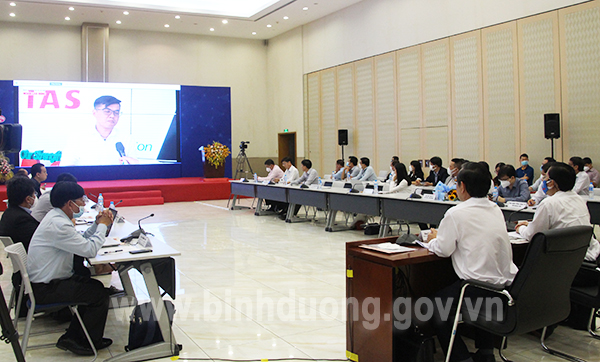
Overview of the seminar
Speaking at the seminar, Mr. Nguyen Van Dich said: "In the coming time, Binh Duong will continue to build a human resource training program with many contents and solutions, suitable for each trained subject. Specifically, for high school students, focusing on improving the quality of education and training; for students of universities and colleges, promoting training associated with the needs of enterprises, especially those in the field of high technology to invest in the province. For workers, the workforce directly in factories and companies, will be interested in training in the direction of improving their skills, industrial manners."
At the same time, the province will expand the model of educational and training institutions, consider implementing training cooperation programs with domestic and foreign universities to conduct training according to the ordering mechanism; encourage and support provincial universities to focus resources on developing high-quality human resource training in high-tech fields to serve the implementation of Binh Duong Smart City and Innovation Region projects. Developing vocational education to meet the requirements of the labor market; promoting streamlining after secondary school, strengthening propaganda and vocational training counseling to create a profound change in awareness of the importance of vocational education for the whole society. Synchronously building the infrastructure of the labor market (career guidance, employment services, information and labor market forecasting) and organizing the the provision of effective public services on employment; surveying and proceeding to build a database and a common portal on recruitment to serve enterprises.
"The province will also study and promulgate mechanisms and policies to encourage enterprises to participate in higher education and vocational education activities, including training, research and development, and to closely link enterprises with educational and training institutions according to the three-house model; encourage vocational education institutions to associate with enterprises for new training, re-training for enterprises, and create conditions for enterprises to participate in vocational training activities" - Vice Chairman of the Provincial People's Committee emphasized.
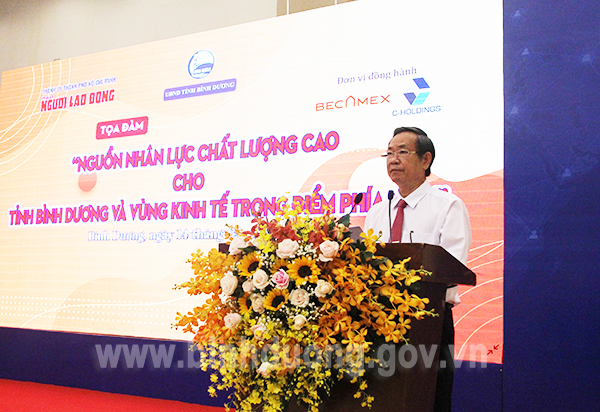
Vice Chairman of the Provincial People's Committee Nguyen Van Danh speaks at the seminar
The province now has more than 53,000 domestic enterprises registered for business, with a total registered capital of more than 515,000 billion VND and more than 4,000 valid foreign-invested projects with a total registered capital of 37 billion USD. The province aims to strive to build Binh Duong for sustainable development in the direction of a smart, civilized and modern city. By 2030, it will become a modern industrial center, and by 2045, a smart city of the region and the country.
Deeply aware of the role and position of improving the quality of human resources in the process of industrialization and international economic integration, the Resolution of the 11th Provincial Party Congress required "Developing a skilled labor force in sufficient quantity, ensuring quality, having a reasonable structure, associating training with job creation, increasing income and improving people's living standards. By 2025, the rate of trained workers will reach 85%, of which only 35% have diplomas and certificates (an average increase of 1%/year). Every year, creating jobs increases by about 35,000 workers".
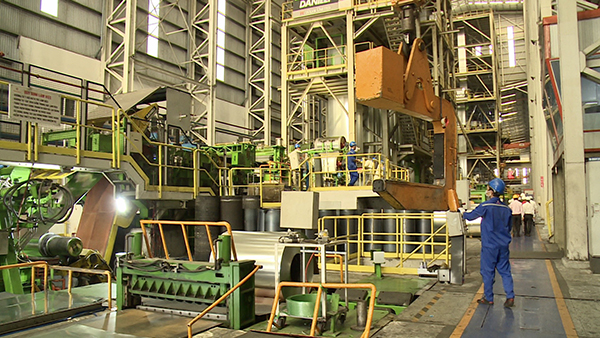
Binh Duong strives that by 2025, the rate of trained workers will reach 85%
Along with that, Binh Duong invests in building the province's vocational education institutions to become high-quality schools with multi-disciplinary training, including key occupations of international, ASEAN and national standards and industries and occupations to attract investment and develop the province's socio-economic development; develops preferential policies for apprentices and create jobs after apprenticeships to attract secondary school graduates to go to vocational training.
Developing high-quality human resources from existing human resources; attracting enterprises to invest in the high-tech field as a driving force to attract and train high-quality human resources for the province; conducting regular investigations and surveys on human resources and human resource quality by training level and socio-economic fields; ensuring the balance between supply and demand of human resources for socio-economic development within the province and in each branch.
Dedicated solutions to improve the quality of human resources
At the seminar, experts, researchers and enterprises shared and raised new solutions and approaches to improve the quality of human resources, meeting the requirements of socio-economic development of Binh Duong province and the Southern Key Region.
Binh Duong is the only province of Vietnam named in the list of "Smart 21" for many consecutive years. In 2021, Binh Duong Smart Region continued to be honored by the Intelligent Community Forum (ICF) in the Top 7 communities with typical smart city development strategies in the world. On the new development roadmap, the province is building a modern investment attraction environment based on the smart city foundation, with a focus on the innovation region, in which high-quality human resources are emphasized as the core factor determining the success of all strategies.
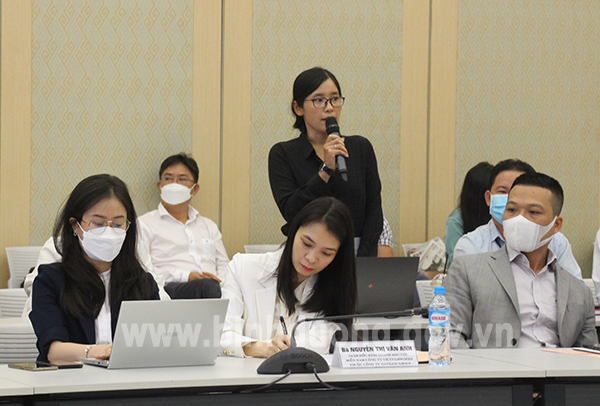
The representative of Becamex IDC Corp presents the human resource training strategy
As an enterprise assigned by Binh Duong province to implement the Smart City Project, contributing to building high-quality human resources for Binh Duong province, Becamex has set out many human resource development strategies, with the motto "people are the focus, every citizen is an investor, how to retain human resources is the key". Becamex has focused on developing Eastern International University, investing and creating conditions to support students in the direction of meeting the needs of enterprises to provide a high-quality workforce for industrial development; the university will also become a knowledge center and technology transfer hub in the province. Currently, Becamex has been completing the Becamex Advanced Manufacturing and Startup Center. This will be a space to train high-tech human resources, support enterprises and promote startups. In addition, in the coming time, Becamex is also aiming to build a number of key projects such as developing Vietnam-Singapore Industry 4.0 Center; Sustainable energy center; World Trade Center Binh Duong New City, etc.
Thu Dau Mot University is one of the prestigious and quality training addresses to meet the human resource needs of Binh Duong and neighboring provinces. Dr. Ngo Hong Diep - Vice President of Thu Dau Mot University affirmed that, in order to contribute to solving the problem of human resources for the locality, when training, the University has developed a training program, accordingly, the output standards include 4 factors: Fluency in foreign languages, integration skills, soft skills; building elements of corporate culture; information technology training; professional capacity. In which, focusing on soft skills training. The university's training program consists of 2 phases, phase 1 includes foundational knowledge. In phase 2, specialized training, creating conditions for students to choose the right major for them. The university provides training in 4 forms: Theory, learning through simulation model; doing typical exercises; participating in training and learning at enterprises. Internship time at enterprises accounts for 40-50%. The orientation of the University is to train output students to meet both domestic and foreign working environments. In the future, the University sets the goal of training human resources to meet the needs of the Southern Key Economic Region and further to the ASEAN market.
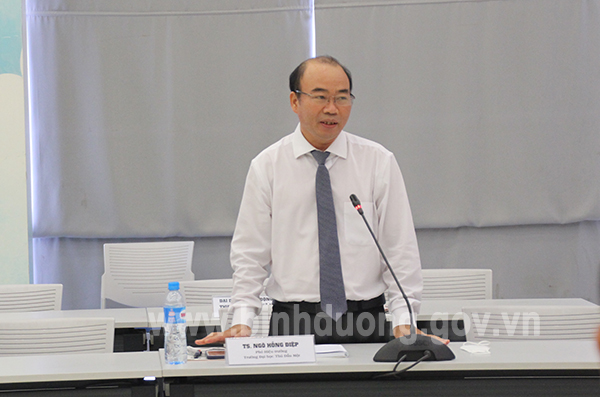
Dr. Ngo Hong Diep - Vice President of Thu Dau Mot University speaks
To overcome the shortage of skilled and qualified workers in the current context, according to Dr. Truong Anh Dung - General Director of the Directorate of Vocational Education, Ministry of Labor, War Invalids and Social Affairs, first of all, is necessary to promote recruitment, training and skill improvement for workers right in the enterprises; the connection between labor supply and demand needs to be promoted and digitized more strongly. In the long term, the Directorate of Vocational Education is developing a 5-year and 10-year roadmap for vocational education for the Southern Key Economic Region. In which, improving the capacity of the contingent of vocational educators, modernizing vocational education and training institutions, renovating training methods, and building flexible training methods. Striving in the near future, in the Southern region, there will be about 30 high-quality vocational training schools, and there are 2 national centers for high-quality vocational training.
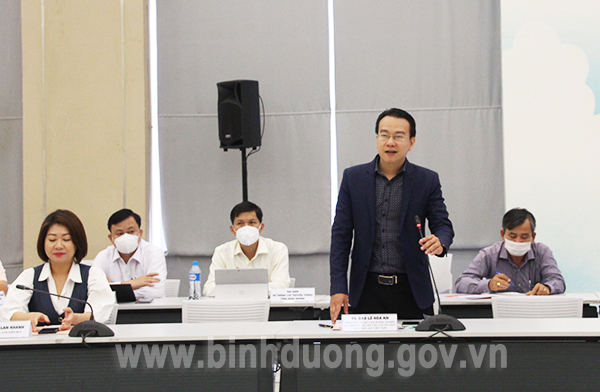
Dr. Dao Hoa An- Director of 4.0 Jobway Career Center presents a proposal for students to be given early career guidance
In addition, there are many solutions proposed by the participants at the seminar: Students must receive early career guidance. Vocational education institutions need to improve training quality to meet training needs and strengthen regional training connections. Most of the current vocational education institutions are following the training curriculum, have not trained according to the needs and have not met the needs of enterprises. Linking human resource training with enterprises, especially enterprises with high demand for human resources, or prioritizing large-scale enterprises with production factories located in big cities and provinces in the region, to meet new industry trends. It is necessary to create conditions for large enterprises to set up factories, recruit high-quality personnel or screen human resources right from training institutions. Connecting general labor information data, etc.
Reported by Yen Nhi- Translated by Thanh Tam